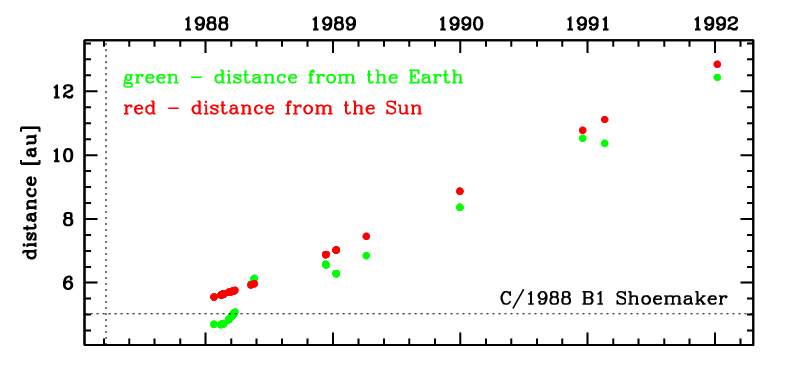C/1988 B1 Shoemaker
more info
Comet C/1988 B1 was discovered by Carolyn S. and Eugene M. Shoemaker (with the 0.46-m Schmidt telescope at Palomar) on 23 January 1988 (IAUC 4547), when the comet was ten months after its perihelion passage. The comet was last seen on 6 January 1992.
The comet made its close approach to the Earth on 4 February 1988 (4.68 au), that was twelve days after its discovery. Slightly deeper close approach to the Earth was in the previous opposition (not observed) when the comet was within 4.62 au from the Earth (12 February 1987, about five weeks before perihelion passage).
Solution given here is based on data spanning over 4.0 yr in a range of heliocentric distances from 5.55 au to 12.85 au.
This Oort spike comet suffers small planetary perturbations during its passage through the planetary system that lead to escape of the comet from the solar system (see future barycentric orbit).
See also Królikowska 2014 and Królikowska and Dybczyński 2017.
The comet made its close approach to the Earth on 4 February 1988 (4.68 au), that was twelve days after its discovery. Slightly deeper close approach to the Earth was in the previous opposition (not observed) when the comet was within 4.62 au from the Earth (12 February 1987, about five weeks before perihelion passage).
Solution given here is based on data spanning over 4.0 yr in a range of heliocentric distances from 5.55 au to 12.85 au.
This Oort spike comet suffers small planetary perturbations during its passage through the planetary system that lead to escape of the comet from the solar system (see future barycentric orbit).
See also Królikowska 2014 and Królikowska and Dybczyński 2017.
| solution description | ||
|---|---|---|
| number of observations | 66 | |
| data interval | 1988 01 23 – 1992 01 06 | |
| data type | observed only after perihelion (POST) | |
| data arc selection | entire data set (STD) | |
| range of heliocentric distances | 5.55 au – 12.9au | |
| detectability of NG effects in the comet's motion | NG effects not determinable | |
| type of model of motion | GR - gravitational orbit | |
| data weighting | NO | |
| number of residuals | 127 | |
| RMS [arcseconds] | 0.98 | |
| orbit quality class | 1a | |
| previous orbit statistics, both Galactic and stellar perturbations were taken into account | ||
|---|---|---|
| no. of returning VCs in the swarm | 4351 | * |
| no. of escaping VCs in the swarm | 650 | |
| no. of hyperbolas among escaping VCs in the swarm | 0 | |
| previous reciprocal semi-major axis [10-6 au-1] | 17.63 – 22.90 – 29.55 | R |
| previous perihelion distance [au] | 1400 – 2400 – 4600 | R |
| previous aphelion distance [103 au] | 66 – 85 – 110 | R |
| time interval to previous perihelion [Myr] | 5.6 – 8.2 – 12 | R |
| percentage of VCs with qprev > 20 | 100 | |
| previous_g orbit statistics, here only the Galactic tide has been included | ||
|---|---|---|
| no. of returning VCs in the swarm | 3777 | * |
| no. of escaping VCs in the swarm | 1224 | |
| no. of hyperbolas among escaping VCs in the swarm | 7 | |
| previous reciprocal semi-major axis [10-6 au-1] | 11.73 – 20.72 – 29.27 | |
| previous perihelion distance [au] | 41 – 210 – 960 | R |
| previous aphelion distance [103 au] | 68 – 96 – 170 | |
| time interval to previous perihelion [Myr] | 5.9 – 9 – 13 | R |
| percentage of VCs with 10 < qprev < 20 | 2 | |
| percentage of VCs with qprev > 20 | 98 | |
